Biking in Merida
If you only have a few days to see Merida, the easiest way may be from the seat of one of the downtown tour buses. Or you can walk the city to get a closer look at what makes Merida special, especially centro historico and Paseo de Montejo. But the more time I spend in Merida, the stronger is my feeling that the best way to explore the city is on the seat of a bike.
Like many, I first came to Merida as a tourist. But as I observed the streets, traffic, and the mix of cars, motorbikes and bicycles, it became clear that Merida is a “bikeable” city. While it initially appears chaotic and tight, once you leave the centro there is plenty of room for riding on relatively smooth, free flowing streets, and there’s quite a lot to see.
When I returned to Merida as a homeowner I quickly acquired a mountain bike. Since then I’ve been on the streets nearly every day that I’ve been here. In four years of touring on two-wheeled transportation, I’ve observed a fascinating variety of neighborhoods, people, shops, parks, markets and food – an eye-opening perspective of Merida impossible to gain on foot in the same amount of time.
I’m an avid cyclist so maybe I’m a bit biased. I’ve been fortunate to bike all over the U.S., parts of Canada, Europe and Cuba. I’ve found Merida to be among the easiest to navigate and one of the most bike “aware.”
It seems to me that bike awareness in Merida and the surrounding community occurs because quite a few people (nearly all men) use bicycles for basic transportation. Drivers take notice and don’t intentionally crowd cyclists. (I’ve been told that penalties for hitting someone on a bike are severe, but I don’t know that to be a fact.)
Even the profusion of motorbikes contributes to an awareness of other forms of transportation, which include large tricycles for transporting people and goods, and occasionally, horse-drawn carts. These more picturesque forms of transportation add to drivers’ awareness of the need to share the road, not only in the city but in the smaller pueblos as well. There, it’s not uncommon to encounter a three-wheeled cycle or cart transporting people, crops, handmade tables and various other goods for long distances.
In Merida, the easiest ride is La Bici Ruta on Sunday, when one side of Paseo de Montejo is shut down in the morning. This regular event offers an easy opportunity to cruise on one of the prettiest streets in the city. Bici Ruta, which means 'bicycle route', brings out families on bikes of all sizes, roller bladers and skate boarders, runners and even dog walkers.
On this day only, used bikes can be inexpensively rented at the Monumento a la Patria and at the Burger King on Prolongacion Montejo. The bici ruta goes all the way up to the Burger King so that you can get a glimpse of Merida norte. And you can ride all the way south to the Plaza Grande and on to L'Ermita to get a feel for centro. It’s fun, easy and a good preparation for riding at other times when there is more traffic. You do have to watch out for runners, and kids who may stop in front of you at any time. But Montejo is a wide street and it’s never too crowded.
During the week I try to get out early and ride every day. For me the best time is from 7:00 am to about 9:30am. Until 8:00 am there are fewer cars and buses. The air is cleaner and cooler. After about 9:00 am, the roads get busy and pollution-filled.
I usually start on Reforma (CA 72) near Parque Santiago and warm up on the cruise up to Avenida Colon. Then I turn right to the Fiesta America Hotel and from there up Calle 60 to the Deportiva Salvador Alvarado. Across from the campo de deporte (the sports field) is a young vendedor who sells fresh squeezed orange juice for 6 pesos (for about 1 liter). It’s cold, refreshing and a great start for an hour or two on the bike.
The weekends are also good times to ride. People get up much later and there are fewer buses. Sunday morning is really a treat and holidays can resemble a scene from a sci-fi movie when you wonder, “Where is everyone?” Occasionally I’ve been the only one on Paseo Montejo.
Pollution is a concern, especially if you get stuck behind a large bus or a motorbike with limited pollution controls. There is a lot of soot coming from those buses and it’s not good for you. That’s why the earlier you ride the better, since the morning air is much cleaner and initially there are fewer buses. There does not appear to be permanent smog over Merida on most days, because the air circulation over the city is very good. At least there's that.
With a few exceptions, most of the city has smooth, paved streets, without many potholes. The major streets are very smooth, although you must be vigilant for the topes (small speed bumps, or metal bumps set into the road). On some streets there are fewer traffic lights because of the use of topes to slow traffic. Also, you must watch out for the yellow pedestrian crossing lanes. You must stop in front of those if someone is crossing, or risk a healthy fine.
The main exception to easy riding in Merida is in the Plaza Grande area and the market area immediate south of the plaza. It is generally so congested with buses and camionetas (except on Sunday and holidays) that I strongly recommend against cycling there. It’s dangerous... peligroso! I try to avoid having to come through there due to the pollution and congestion. I don’t recommend riding the Periferico, either. It’s too busy, noisy, dusty and fast to make it a fun experience. The Periferico is quickly being turned into a modern freeway, so it really is unsuitable for bicycle riding.
Traffic can be fast on some streets (30 mph+) and you must at all times observe the lights and easily-learned traffic etiquette, especially at the glorietas (roundabouts). Merida is no place for jumping lights or blowing through stop signs as some cyclists do in the States. Those sorts of things will get you hurt here. I make a point of stopping and waiting at all lights even if it is clear. I think it’s key to show drivers (and la policia!) that you respect the legal and social traffic rules.
Going through a stop sign is one of the biggest causes of accidents that I’ve observed. Most drivers don’t slow if they have the right of way. They assume that you will stop at the sign, so you’d better do it. Signaling your intentions at turns or busy corners is also a good practice, especially if there is traffic behind you. Drivers are watching to see what you are going to do.
Without doubt the best two-wheeler for Merida is a mountain bike or a city bike with wider tires. With occasional potholes, topes, rail tracks, cobblestones or grates in the road, thin-tire road bikes could be dangerous. And I very strongly discourage city riding for children, or parents towing those little trailers popular in the states. While drivers are highly aware and accepting, being around large buses and frequently stopping camionetas with children is something I would be very concerned about.
Here are some of the great streets for cruising and touring:
- Paseo de Montejo
- Avenida Colon
- Avenida Cupules
- Reforma (Calle 72)
- CA 59/Avenida Fidel Velázquez (all the way across town)
- Avenida Aleman/Avenida Yucatan
- Avenida Felipe Carillio Puerto/Avenida Correa Rancho
- Campestre Blvd.
- the Circuito Colonias
- CA 111 ( Cic. Colo. south)
- Avenida Jacinto Canek
- Avenida Juan Pablo (CA 65A)
- Avenida Alfredo Barerra, CA 20/32 (norte, Frac. De Montejo)
Favorite destinations include:
- Parque de Las Americas
- Monumento a la Patria
- Parque de Santa Ana
- Parque Santiago
- Museo de Ferrocarril (Railroad Museum)
- the restored Estacion de Ferrocarriles (Train station on CA 55y48)
- Parque Recreativo de Oriente (Frac. Del Parque)
- Unidad Deportiva Kukulkan (close to where Los Leones plays and where a great pool is)
- Complejo Deportiva Inalambrica (near the Tribunal Superior de Justica, Frac. Inalambrica)
- Aqua Parque (Frac. Vergell III)
- Parque Ecologico del Poniente (Frac. Yucalpeten)
- Parque Centenario
- Panteon Florido
The local and state governments are re-paving many streets and quite a few offer long stretches of steady rolling. If you are planning to ride, I recommend buying the city map in booklet form. Some of the larger newsstands or booksellers carry it. With a map book you can easily reference streets without having to refold and refold. Most pages cover large areas of the city with every street printed and readable.
One big problem for tourists is a source of bike rentals. As I write this, it’s not easy if you are here for a short time. One good source of rentals is Ecotourism Yucatan, an established local tour company. They have well-maintained Mongoose mountain bikes and good rental prices at $150 pesos a day (As of March 2009). They will also deliver for a fee. They also rent cars at good rates and can organize tours to local Mayan sites. English is spoken, as well as Spanish, and they are pleasant to deal with.
If you are planning a stay of a month or so and want to ride a lot, I recommend bringing a bike. You can get a decent mountain bike at Target or Sports Authority for about $200 (or less on sale). Leave it partially assembled in the original store box and pay the $25-$50 oversize or second baggage fee.
Some of the local bike shops (Bici-Moto, or Bici-Maya) can assemble it for a couple hundred pesos. Those shops, as well as Costco in Merida, carry mountain bikes and fat tire touring bikes, but you should expect to pay around $350 or more for a decent bike. You might even be able to sell your U.S. bike to a bike shop when you leave, or ask around at the English Library and sell it to an expat. Good bikes at relatively inexpensive prices are still rare. You could also by a tricycle, or tricicleta... trici, for short. Those cost about $2000 pesos (or $200 USD) new and you can sometimes find used ones for sale. They are slower to ride, harder to store, and harder to steer, but easier to balance, and of course, they allow you to bicycle with a friend or a bag of groceries.
A helmet is a must. The pavements are hard and the curbs are often high, with no cut-in ramp access as in the U.S. Again, helmets are a U.S. purchase, if you can manage it. The selection and price in the states is unbeatable; In Merida, they aren't as easy to find and the selection isn't good, as helmets, although required, are not really big here among adults. You can pick up a more-than-adequate helmet in the $30-40 range at a bike store or discount store like Target in the States. While you are there, you might also invest in a set of padded gloves which you will find useful. An hour or so on the bike, even with padded grips, will make you glad to have those gloves!
Right now I’m in the city periodically and would be glad to answer any cycling questions. Drop me a line at: reggmc @mac.com or leave a comment on this article.
There are a few regular riders in the expat community and I have occasionally noticed local riders on road bikes. So far I’ve not made contact with any local groups or riders. There is even a professional road race in Yucatan in the spring! There's a lot to do on a bicycle in Merida... if you have found other great places to ride or know of other biking resources, please share with us in the Comments section.
Caminos Felices... or, as we know the phrase, Happy Trails!




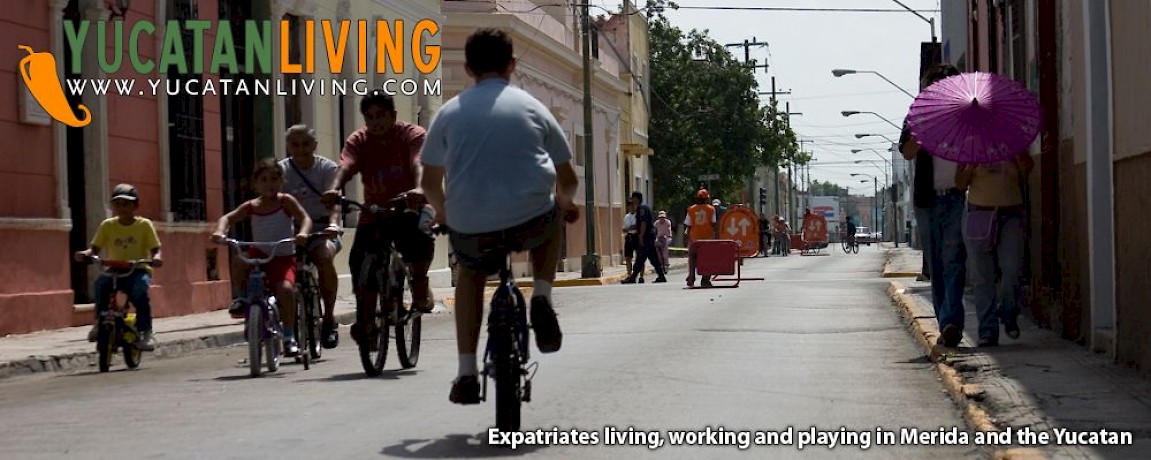


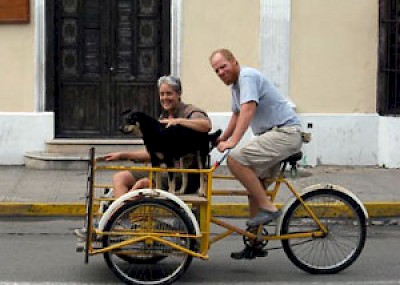
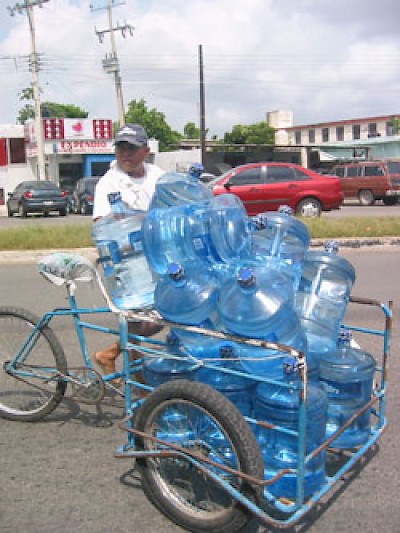

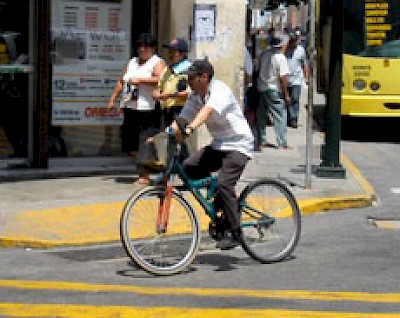
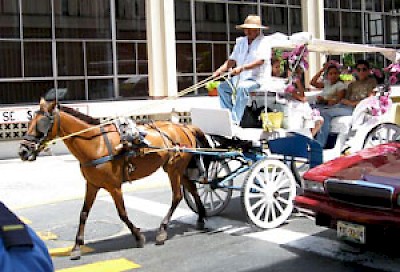
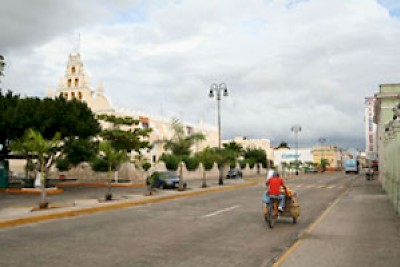
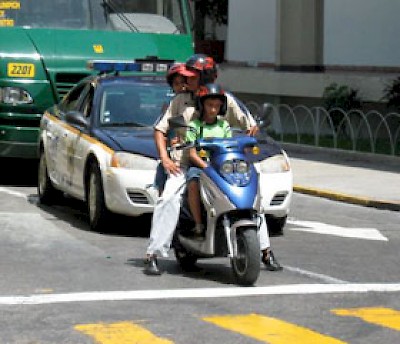

Comments Write a comment
Mario Novelo 16 years ago
A few years ago while taking pictures of the "Merida plaques" (yes, those signs you see in several corners in Merida depicting various activities as well as pets, animals, etc.) I decided to save my feet (in previous years I had been doing the same while in foot) and I got a loaned bike and embarked on my "adventure". Other than the aforementioned centro streets, where you definitely should be very aware of your surroundings if you were to ride there, most neighborhoods were very easy to ride and I got to know more of the city where I was born without the pain excessive walking causes.
Unfortunately, the one thing I do while biking in the states (riding in sidewalks) is not possible in Merida due to the various forms/dimensions of the city's sidewalks, so I became very cautions and aware of the traffic patters to avoid being hit. This year when I come to Merida in September I like to ride a bike again (trouble is, so far I have not procured a bike yet) and this year I will probably follow the advice given here and bring with me a helmet which I can always leave in my house and use the following year even if my visit is only for a week this time around.
I too, enjoyed Reg's bike article and I am looking forward to once again enjoy Merida's streets on a bike when I am there in September (11th through 19th).
Reply
Lisa 16 years ago
I lived in Merida for two years in the early 1970's and I just returned from Merida. The center and the older neighborhoods have not changed much. For the two years that I lived there I traveled around the city by bicycle. It was a great way to get around.
Reply
james 16 years ago
Great read. I bike frequently for regular errands and transportation and advocate the use of bikes for short distances... Especially if you equip the bike to easily carry groceries and other items.
Ed: a mistake many cyclists make is riding in the gutter in an attempt to avoid cars. It is important to "take the lane" in the right 1/4 of the lane - as to make your presence known and allow traffic to pass you when safe, rather than crowd you out. If you're seen you're less likely to get "right hooked" from a turning car. Same goes for intersections: Take your spot in the lane a car would stop.
That's helped me commute to work and back via bike safely for seven years at least.
All the best -
James Van Dellen / Denver
Reply
Kathleen 16 years ago
Hi Reg, I really enjoyed your article and would love to ride the streets and outskirts of Mérida some day in the future. I am hoping to be there next February so if you are in town perhaps we could chat.
Kathleen
Reply
CARLOS DANIEL GALLEGOS 16 years ago
I will also encourage caution when it comes to traffic in Merida. I agree with Ed, sad to say. Merida traffic does not respect Pedestrians. There is no "Pedestrians have the right of way" rule in Merida. You cross the streets speedily, or you will get hit. My wife, Ariadna, who was born in Merida and still lives there, says you take your life in your own hands when you cross the busy streets. For a person like me, who has all his toes amputated, and finds it hard to walk, it was like trying to play dodge ball when I crossed the streets in the Centro. Also, the intersection where the WalMart is at on Paseo de Montejo is rather difficult. I've come close to being road kill a few times! There are often specially designated walkways, like near Hospital IMSS Juarez, where Pedestrians can cross safely. Other than those special walkways, you take a great risk crossing the street. One time I became angry in the Centro. I asked an Officer "Do not Yucatecos respect the right of Pedestrians to cross the street safely?". He read me the riot act, saying that Yucateco ways are not the same as the ways of Gringos, from Los Estados Unidos. So, when riding your bike, take care to be very observant of the traffic and the traffic rules and customs around you.
Reply
Ed 16 years ago
Not sure I agree. I would be VERY hesitant to ride the streets of Merida. No one seems to respect the pedestrian let alone the bicyclist.
Reply
Hammockman 16 years ago
Great article. My wife recently purchased a bike from Bicimotos and most mornings find her out riding and exploring the neighborhoods. She, too, thinks it is great fun and that Merida is a very bike friendly city.
Reply
« Back (20 to 27 comments)